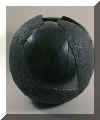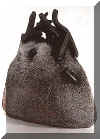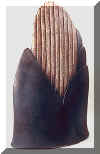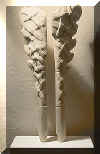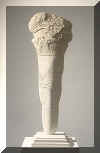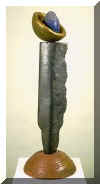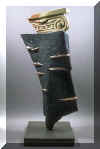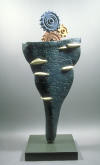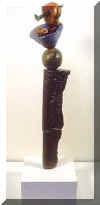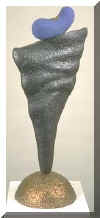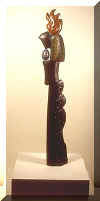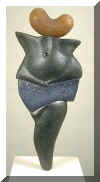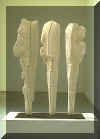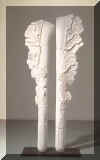Ceramic sculpture: Site specific 1982
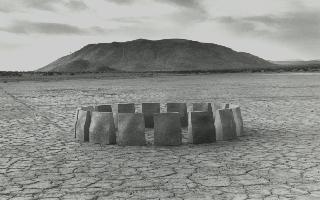
"Dial-O" 1982. Ceramic sculpture, diameter 10 feet.
Single module 21" x 17" x 8" HWD.
Photographed by Robert Treat near Giant Rock
Yucca Valley, California
Voices from the past: "The remarkable and continuing growth of Robert Glover in the realm of ceramic sculpture has already firmly established him as one of our finest artist-craftsmen practicing in this fascinating creative field today. His intimate involvement with the earthy, the organic form life he finds around him, has gone beyond craftsmanship and has become truly a fine art" Bentley Schaad, painter.
"Robert Glover's ceramic forms combine the ease and elegance of the accomplished craftsman, a voluptuousness supported by a hard, boney underlying structure felt by a keen observer of nature, the freedom of imagination...the sensitivity of the artist. His expression is one of strength, as well as, delight." Helen Richter Watson, ceramic artist.
Slab and coil construction. Stoneware clay with oxide stains. Reduction fired to cone 10. No.1 and 4 in private collections. Courtesy of Wiganll Museum (Chaffey College) and Space Gallery Los Angeles. Space gallery exhibited Glover's work from 1976 through 1995.
Ceramic
Sculpture: "Concretus Series" 1989: Three sections.
Coil/Slab construction. Colored clays and bronze metallic
glaze. Earthenware cone 04. Courtesy: Space Gallery.
VESSEL FORMS Ceramic vessels
1985: Slab/coil construction. carved and glazed. Earthenware with
layered metallic bronze and pewter glazes cone 04. Final luster glaze cone 019
Courtesy: Space Gallery.
Ceramic
"Anti-Vessel" Series 1980: Slab/coil construction.
Earthenware. Textured and overglaze stains and metallic
oxides. Multiple firings at cone 04. Courtesy: Space Gallery.
Slab/Coil
"Matrix" series. 1981-1982
Slab/Coil
series. 1977 Courtesy: Space Gallery No. 18 and 19 in private collections.
No. 21-SPACE Gallery, Los Angeles,
CA. Installation 1987. Ceramic sculpture from the solo exhibition.
White unglazed earthenware fired in sections and assembled on an armature.
"Concretus" Series.
The above examples are in private collections: Image No. 1, 4, 5, 6, 7, 9,
10, 11, 13, 14, 16,18,19, 20, 23.
Examples of
work shown at LA Artcore Click on
any image to enlarge
 5
5
 6
6
 7
7 10
10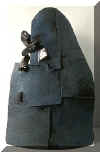 16
16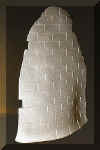 18
18
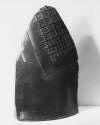 19
19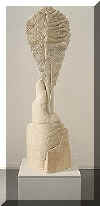 21
21
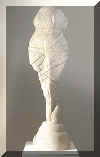 23
23
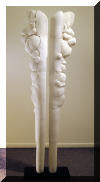 24
24
Photo survey: Collection of sculptures and vessels. Media: Ceramics. Technique: Coil and slab. Carved and applied texture. Multiple low fired glazes and unglazed surfaces. No.1, 3 & 5, 1995. No.2, 1997. No.7 / 1989. No. 4 & 6, 1994. The above examples (No.1, 2, 4, 6, 8, 9,10 and 11) are in private collections. No.8 / 1985 in the permanent collection of the Oakland Museum of Art. Photo 3: Ceramic Sculpture-"Yadada" 1997. H37"xW17"xD4" multi-layered low temperature glazes, metallic lusters, on earthenware textured, coil and slab construction. Exhibited at the Kitakyushu Municipal Art Gallery, Kitakyushu, Japan Nov. 1997.Curator, Yoshio Ikezaki
Exhibition photo (above) covering 22 years of Glover's work as presented by LA Artcore Center at Union Center for the Arts, 120 Judge John Aiso Street (Little Tokyo) in Los Angeles. Website: http://www.laartcore.org Phone 213.617.3274 FAX 213 616.0303
A sixteen page catalog representing the survey is available upon request. The catalog cover is printed with duotone metallic pigments and the pages contain large detailed color photos (8 pages) and black/white photos (6 pages). The catalog size is approximately 8 x 11 inches. A limited amount are availabe.The cost is $25 for the catalog and includes shipping. Contact by e-mail.
Catalog thumbnail view
Catalog Introduction
Robert Glover: A Survey of Work
Melding the artistic traditions of ceramics and sculpture. Robert Gloverís works of the last three decades manifest clayís potential as an autonomous artistic medium. Fusing the processes of craft and fine art, once regarded as mutually exclusive, his pieces play at the nexus between the two exploring clayís substantive, structural and conceptual relationship to nature and life. While evidencing a profound interest in abstract form that reaches towards prehistory through Brancusi, these works simultaneously extend the legacy of mid-twentieth century craft innovators such as Peter Voulkos (Peter Voulkos:Clay,Space,andTime-Sculpture.org ) with whom Glover once studied.
His early sculptures of the Ď7Os are fin-like slab constructions that visually culminate in a matrix of wild and tangled tubular projections. Simultaneously lyrical and disturbing, these works carry Romantic innuendoes of nature as seemingly pure and ideal, but threatened and haunted by chaos and disorder. Such paradoxes are sublimated in Gloverís early Ď8Os site-specific installations that were configured in desert terrains. Projecting ancient and celebratory cadences, those minimalist pieces forged a path towards the menhir like sculptures that have occupied the artist in recent decades,
Echoing with the memories of Stonehenge. Celtic menhirs, and of their implicit significance as markers of human existence. Gloverís early monolithic sculptures were inspired by desert dust devils. Fabricated of unglazed earthenware, they assert a stately but reserved presence, disclosing extraordinarily intricate pumice-like surfaces that recall weatherworn coral or stone. Like so many of Gloverís works these lyrical works are infused with metaphors of nature and growth. At the same time, their stone-like hue and immobility murmur with the promises of permanence, yet bear the traces of former transient and molten existence. While made of material substance, these pieces project a ghostly, spiritual immateriality.
By contrast the sculptures of the Ď90s, establishing an unequivocal presence, endowing form with poetic color. The leitmotif of growth is reconsidered, often brought to an equivocal climax that features primary forms such as an ovoid egg or kidney bean finial. Inverting tales of progress and evolution, these sculptures emphasize the cycles of lifeís repetitions, intoning the indeterminacy of existence. In Classic Gas, a crowning Greek Ionic capital form sinks into the stratums of time presented as a sculpted wedge, while technological gears meet a similar fate in Yadada. Paradox thus emerges as a central theme in these sculptures that find an intriguing counter fugue in Gloverís nonfunctional vessels.
Numerous ceramic vessels embrace and enclose an interior space that remains unseen. Projecting a sense of fullness and well-being, these spherical orbs bespeak a world of equilibrium. Such equanimity is antithetical to the sculptures where space is often caught and trapped between component parts, while form plays upon the razor edges of balance. Thus, in rarified moments, Gloverís works find profound equilibrium while in others the improbability of such ambitions remains predominant. With honesty and conviction, his works move from the physical to the metaphysical realm considering the impossible promise of weighing and balancing time, space, and narrative.
Collette Chattopadhyay
Updated file: 04-014-2012





